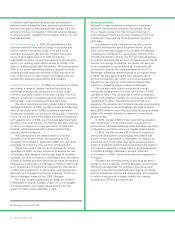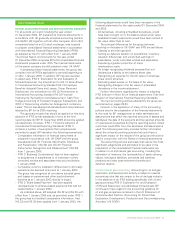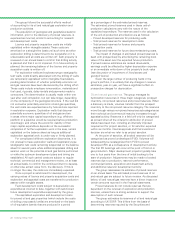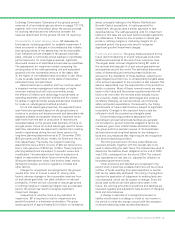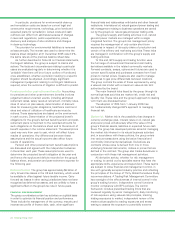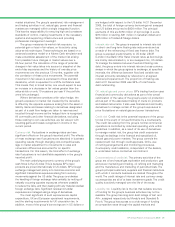BP 2005 Annual Report Download - page 32
Download and view the complete annual report
Please find page 32 of the 2005 BP annual report below. You can navigate through the pages in the report by either clicking on the pages listed below, or by using the keyword search tool below to find specific information within the annual report.
30 Making energy more
consent of the venturers. A jointly controlled entity is a joint venture
that involves the establishment of a company, partnership or other
entity to engage in economic activity that the group jointly controls
with its fellow venturers.
The results, assets and liabilities of a jointly controlled entity are
incorporated in these financial statements using the equity method
of accounting. Under the equity method, the investment in a jointly
controlled entity is carried in the balance sheet at cost plus post-
acquisition changes in the group’s share of net assets of the jointly
controlled entity, less distributions received and less any impairment
in value of the investment. The group income statement reflects the
group’s share of the results after tax of the jointly controlled entity.
The group statement of recognized income and expense reflects the
group’s share of any income and expense recognized by the jointly
controlled entity outside profit and loss.
Financial statements of jointly controlled entities are prepared for
the same reporting year as the group. Where necessary, adjustments
are made to those financial statements to bring the accounting
policies used into line with those of the group.
Unrealized gains on transactions between the group and its jointly
controlled entities are eliminated to the extent of the group’s interest
in the jointly controlled entities. Unrealized losses are also eliminated
unless the transaction provides evidence of an impairment of the
asset transferred.
The group ceases to use the equity method of accounting on the
date from which it no longer has joint control over, or significant
influence in the joint venture, or when the interest becomes held
for sale.
Certain of the group’s activities, particularly in the Exploration and
Production segment, are conducted through joint ventures where the
venturers have a direct ownership interest in and jointly control the
assets of the venture. The income, expenses, assets and liabilities
of these jointly controlled assets are included in the consolidated
financial statements in proportion to the group’s interest.
INTERESTS IN ASSOCIATES
An associate is an entity over which the group is in a position to
exercise significant influence through participation in the financial
and operating policy decisions of the investee, but which is not a
subsidiary or a jointly controlled entity.
The results, assets and liabilities of an associate are incorporated
in these financial statements using the equity method of accounting.
Under the equity method, the investment in an associate is carried in
the balance sheet at cost plus post-acquisition changes in the group’s
share of net assets of the associate, less distributions received and
less any impairment in value of the investment. The group income
statement reflects the group’s share of the results after tax of the
associate. The group statement of recognized income and expense
reflects the group’s share of any income and expense recognized by
the associate outside profit and loss.
The financial statements of associates are prepared for the same
reporting year as the group. Where necessary, adjustments are made
to those financial statements to bring the accounting policies used
into line with those of the group.
Unrealized gains on transactions between the group and its
associates are eliminated to the extent of the group’s interest in the
AUTHORIZATION OF FINANCIAL STATEMENTS AND STATEMENT OF
COMPLIANCE WITH INTERNATIONAL FINANCIAL REPORTING STANDARDS
The financial statements of the BP group for the year ended
31 December 2005 were authorized for issue by the results
committee on behalf of the board of directors on 6 February 2006 and
the balance sheet was signed on the board’s behalf by Peter
Sutherland and The Lord Browne of Madingley. BP p.l.c. is a public
limited company incorporated and domiciled in England and Wales.
The company’s ordinary shares are traded on the London Stock
Exchange. The consolidated financial statements have been prepared
in accordance with International Financial Reporting Standards (IFRSs)
as adopted by the European Union (EU) and in accordance with the
provisions of the Companies Act 1985. The consolidated financial
statements have also been prepared in accordance with IFRSs as
issued by the International Accounting Standards Board (IASB). The
principal accounting policies adopted by the group are set out below.
BASIS OF PREPARATION
This is the first year in which the group has prepared its financial
statements under IFRSs and the comparative financial information
has been restated from UK generally accepted accounting practice
(UK GAAP) to comply with IFRSs. Reconciliations to IFRSs from the
previously published UK GAAP primary financial statements are
shown in Note 50. The accounting policies that follow set out those
policies that apply in preparing the consolidated financial statements
for the year ended 31 December 2005.
The consolidated financial statements are presented in US dollars
and all values are rounded to the nearest million dollars ($ million),
except where otherwise indicated.
BASIS OF CONSOLIDATION
The group financial statements consolidate the financial statements
of BP p.l.c. and the entities it controls (its subsidiaries) drawn up to
31 December each year. Control comprises the power to govern the
financial and operating policies of the investee so as to obtain benefit
from its activities and is achieved through direct and indirect
ownership of voting rights; currently exercisable or convertible
potential voting rights; or by way of contractual agreement.
Subsidiaries are consolidated from the date of their acquisition, being
the date on which the group obtains control, and continue to be
consolidated until the date that such control ceases. The financial
statements of subsidiaries are prepared for the same reporting year
as the parent company, using consistent accounting policies.
All intercompany balances and transactions, including unrealized
profits arising from intragroup transactions, have been eliminated in
full. Unrealized losses are eliminated unless the transaction provides
evidence of an impairment of the asset transferred.
Minority interests represent the portion of profit or loss and net
assets in subsidiaries that is not held by the group and is presented
separately within equity in the consolidated balance sheet.
INTERESTS IN JOINT VENTURES
A joint venture is a contractual arrangement whereby two or more
parties (venturers) undertake an economic activity that is subject to
joint control. Joint control exists only when the strategic financial and
operating decisions relating to the activity require the unanimous
Accounting policies


